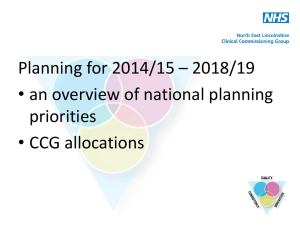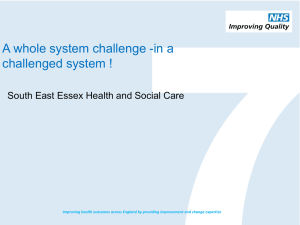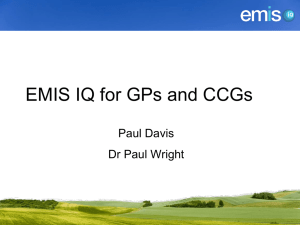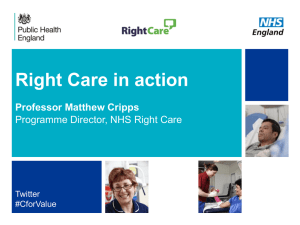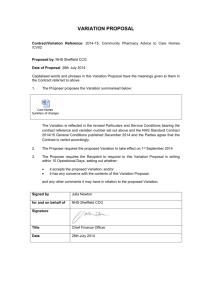Interpreting the Commissioning for Value Packs
advertisement
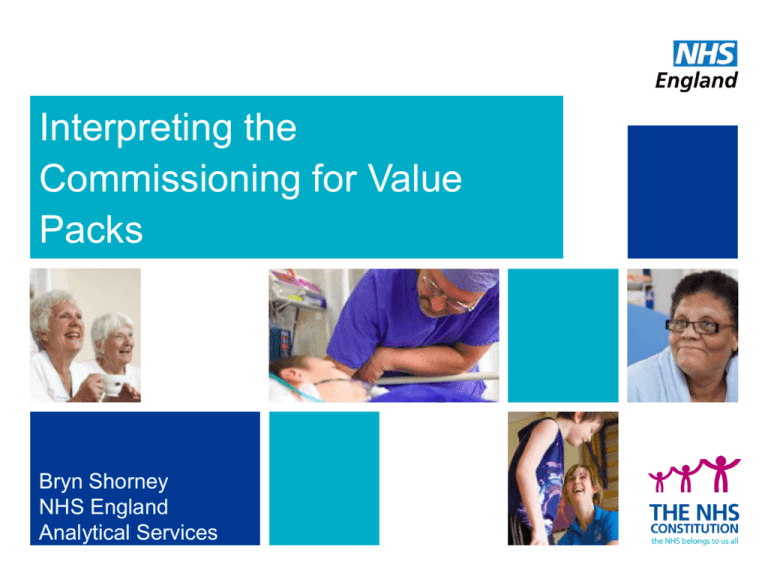
Interpreting the Commissioning for Value Packs Bryn Shorney NHS England Analytical Services Commissioning for Value: Recap • • October 2013 – Original packs compared CCG performance on a large range of indicators and identified potential opportunities to improve. November 2014 – ‘Pathway on a Page’ packs investigated thirteen areas in more detail. • • • Original packs were Phase 1 ‘Where to Look’. They helped CCGs/CSUs to identify areas in which to perform a deep dive to look into ‘What to Change’. The ‘Pathway on a Page’ packs fit between Phase 1 and 2: a mini deep dive that CCGs/CSUs can build on to perform a more in-depth investigation. CfV and Right Care websites include examples/guides to help CCGs/CSUs perform a deep dive. February 2015 – Integrated Care packs including pathways on a page for cross-cutting areas such as Maternity and Early Years and analysis of CCGs’ most complex patients. November 2014 – Pathways on a Page • Compared CCG performance on a range of indicators for thirteen of the highest areas of expenditure; • • • • • • • Breast Cancer Lower gastrointestinal cancer Lung cancer Diabetes Psychosis Common mental health disorders Heart disease • Neurology has since been added to the interactive tool • As with the original packs, CCGs are compared to their ten most similar CCGs – methodology and data are available on the CfV website. • Pathways designed with National Clinical Directors and Intelligence Networks – intended to capture as much information about the patient pathway as possible (availability of data does vary between areas). • • • • • • Stroke COPD Asthma Musculoskeletal Trauma and injury Renal CCG A: Higher non-elective spend and mortality rates 4 NHS | Presentation to [XXXX Company] | [Type Date] CCG B: Better primary care and lower non-elective spend 5 NHS | Presentation to [XXXX Company] | [Type Date] CCG C: High mortality rates but COPD seems to be well managed in primary care. Underlying prevalence is high. 6 NHS | Presentation to [XXXX Company] | [Type Date] Interactive Commissioning for Value tool • The following slides show how the Commissioning for Value tool can be used to explore indicators in a pathway in more detail • The tool allows users to view bar charts, spine charts and maps for each indicator • The tool allows comparisons of CCGs with the national distribution, filtered by region and any selected CCGs (e.g. with the similar ten CCGs used in the packs) • There is also an explorer tool which allows users to explore the relationship between two different indicators via scatterplots • The tool can be found on the CfV website. The previous version of the tool that accompanies the original packs is also still available on the website. CCG C: Highest mortality rates for bronchitis, emphysema and COPD compared to similar ten CCGs 8 NHS | Presentation to [XXXX Company] | [Type Date] CCG C: Third highest spend on non-elective COPD admissions compared to similar ten CCGs 9 NHS | Presentation to [XXXX Company] | [Type Date] CCG C: Second highest reported prevalence of COPD compared to similar ten CCGs 10 NHS | Presentation to [XXXX Company] | [Type Date] CCG C: Highest ratio of reported to estimated prevalence of COPD compared to similar ten CCGs. The CCG is better at identifying COPD so this is coloured green in the pathway. 11 NHS | Presentation to [XXXX Company] | [Type Date] CCG C: Highest % of FEV1 (lung function test) compared to similar ten CCGs 12 NHS | Presentation to [XXXX Company] | [Type Date] CCG C: Highest % of patient reviews compared to similar ten CCGs. CCG C appears to identify and manage COPD well but high prevalence drives high spend and mortality rates. 13 NHS | Presentation to [XXXX Company] | [Type Date] February 2015 – Integrated Care packs • • Feedback received after the original packs was that you wanted more of a focus on integrated and non-acute care. Availability of data is a problem for non-acute care but we have included the following analysis; • • • • • • Maternity and Early Years Pathway (Local Authority level) Inpatient expenditure for 0-4 year olds (CCG level) Substance Misuse and Mental Health Pathway (Local Authority level) Dementia and Long Term Conditions Pathway (CCG level) Inpatient expenditure for 75+ year olds (CCG level) Analysis of the CCGs’ most complex patients (CCG level) • As with the original packs, CCGs and LAs are compared to their ten most similar CCGs/LAs – methodology and data are available on the CfV website. • Pathways designed with National Clinical Directors and Intelligence Networks – intended to capture as much information about the patient pathway as possible (availability of data does vary between areas). Local Authority A: Worse than similar LAs on public health elements of Maternity pathway and higher spend on hospital admissions in Early Years 15 NHS | Presentation to [XXXX Company] | [Type Date] Complex patients • • • Based on analysis of inpatient data (SUS) But intended to capture patients who are likely to be intensive users of other parts of the health and social care system (but we do not have data for these areas) Locally CCGs/CSUs/LAs will have better access to information for primary care, community care, Mental Health, social care, etc. • Identified the 2% of patients that CCGs spend the most on for inpatient admissions covered by payment by results tariff • Not the 2% of patients covered by the enhanced service…. …but comparing these sets of patients locally may be a very useful exercise • • • • • • The 2% of patients comprise 15% of spend on inpatient admissions. The average complex patient has 6 admissions per year for three different conditions (based on programme budget categories). 59% of these complex patients are aged 65 or over 37% of these complex patients are aged 75 or over 13% of these complex patients are aged 85 or over 92% of the complex patients also had an outpatient attendance and 81% also had an A&E attendance during the year. CCG D: Spends £11.7 million on 579 complex patients and £0.7 million on 27 children aged under one 17 NHS | Presentation to [XXXX Company] | [Type Date] CCG E: More complex patients aged over 75 and less aged 55 to 74 compared to similar CCGs 18 NHS | Presentation to [XXXX Company] | [Type Date] CCG F: More complex patients for Gastro Intestinal, Respiratory, and Musculoskeletal 19 NHS | Presentation to [XXXX Company] | [Type Date] CCG G: For 180 patients Circulation was the main condition and 54 of these patients also had an admission for Respiratory problems during the year 20 NHS | Presentation to [XXXX Company] | [Type Date] CCG H: For 375 patients Gastro Intestinal was the main condition and this was the most common co-morbidity for each of the other main conditions 21 NHS | Presentation to [XXXX Company] | [Type Date] CCG J: Co-morbidities of Cancer include Infectious diseases and poisoning and adverse effects 22 NHS | Presentation to [XXXX Company] | [Type Date] CCG K: Over 50% of the A&E attendances for complex patients are for those who have more than 5 attendances a year - which is 21% of patients (3.2% more than similar CCGs) 23 NHS | Presentation to [XXXX Company] | [Type Date] Next Steps and Further Information • • • Use the commissioning for value tools to explore the pathways in more detail Perform a full deep dive investigation into the areas which appear to offer the greatest potential improvements Use local data to explore spend, activity and outcomes in more detail, e.g.; • High spend procedures/drugs • Spend/activity in other settings (e.g. community care) • GP Practice level variation • Re-produce the complex patients data locally to identify operational (patient level) and strategic (service/system level) improvements • Are you making the most of risk stratification models? • • • Learn from the best performing CCGs (Right Care website and local knowledge) Assess evidence on best practice pathways, e.g. NICE guidance Establish clinical leaders to lead service redesign projects • See the website for further information; http://www.england.nhs.uk/resources/resources-for-ccgs/comm-for-value • If you have any questions please get in touch; england.healthinvestmentnetwork@nhs.net
